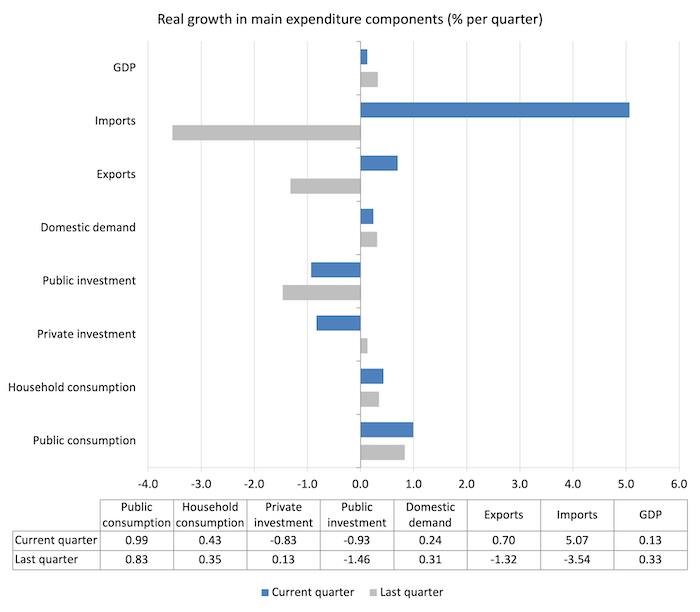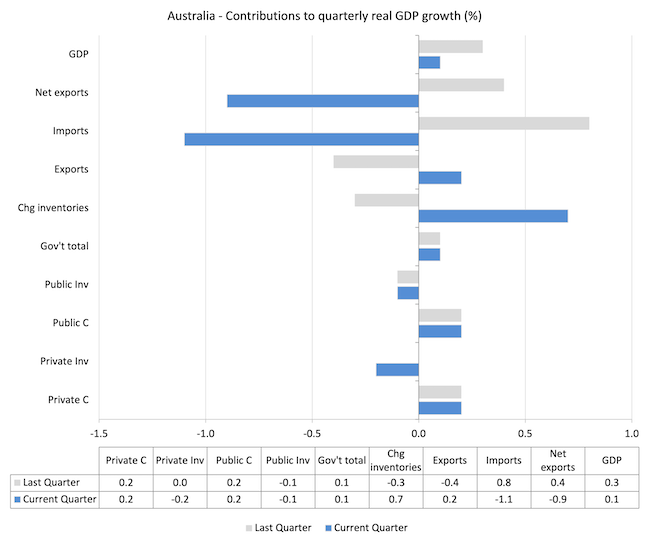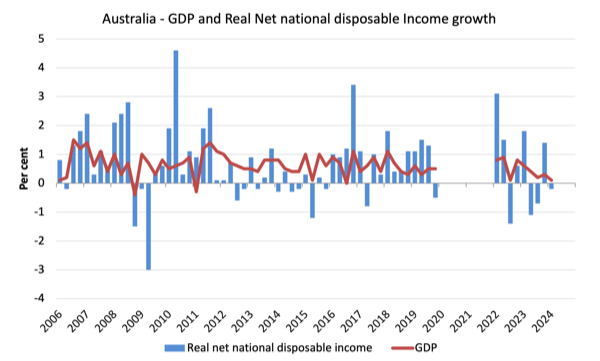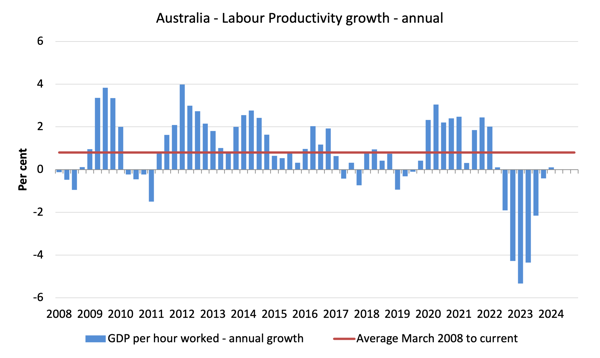I am travelling today to Tokyo and have little time to write here. But with…
Australia – GDP growth heads towards zero – then recession if there is no policy shift
Today (June 5, 2024), the Australian Bureau of Statistics released the latest – Australian National Accounts: National Income, Expenditure and Product, March 2024 – which shows that the Australian economy grew by just 0.1 per cent in the March-quarter 2024 and by 1.1 per cent over the 12 months (down from 1.5 per cent). If we extend the March result out over the year then GDP will grow by 0.4 per cent, well below the rate required to keep unemployment from rising. GDP per capita fell for the fifth consecutive quarter and was 1.3 per cent down over the year. This is a rough measure of how far material living standards have declined but if we factor the unequal distribution of income, which is getting worse, then the last 12 months have been very harsh for the bottom end of the distribution. Household consumption expenditure was stable but only because the saving ratio fell further. There is now a very real possibility that Australia will enter recession in the coming year unless there is a change of policy direction. Both fiscal and monetary policy are squeezing household expenditure and the contribution of direct government spending, while positive, will not be sufficient to fill the expanding non-government spending gap. At the current growth rate, unemployment will rise. And that will be a deliberate act from our policy makers.
The main features of the National Accounts release for the March-quarter 2024 were (seasonally adjusted):
- Real GDP increased by 0.1 per cent for the quarter (down from 0.3 per cent last quarter). The annual growth rate was 1.1 per cent (down from 1.5) but the annualised December-quarter rate would only be 0.4 per cent
- GDP per capita fell by 0.4 per cent for the quarter, the fifth consecutive quarter of contraction. Over the year, the measure was down 1.3 per cent – signalling declining average income.
- Australia’s Terms of Trade (seasonally adjusted) rose by 0.2 per cent for the quarter but were down by 7.3 per cent over the 12 month period.
- Real net national disposable income, which is a broader measure of change in national economic well-being, fell by 0.2 per cent for the quarter and 0.5 per cent over the 12 months, which means that Australians are worse off (on average) than they were at that point 12 months ago. Averages are deceiving when the underlying distribution is highly skewed.
- The Household saving ratio (from disposable income) fell to 0.9 per cent from 1.6 per cent – as households run down their saving to stay afloat.
Overall growth picture – growth continues at much slower rate
The ABS – Media Release – said that:
Australian gross domestic product (GDP) rose 0.1 per cent in the March quarter 2024 and 1.1 per cent since March 2023 …
GDP growth was weak in March, with the economy experiencing its lowest through the year growth since December 2020. GDP per capita fell for the fifth consecutive quarter, falling 0.4 per cent in March and 1.3 per cent through the year …
Total capital investment fell 0.9 per cent … Private investment fell by 0.8 per cent driven by a decline of 4.3 per cent in non-dwelling investment …
Public capital investment fell for the second straight quarter …
Net trade detracted 0.9 percentage points from GDP growth this quarter, with stronger imports (+5.1 per cent) than exports (+0.7 per cent) …
Compensation of employees (COE) rose 1.0 per cent in the March quarter, the smallest growth since September 2021. This indicates slowing growth in the labour market …
The household saving ratio fell to 0.9 per cent in the March quarter after rising last quarter … Household income received grew at its lowest rate since December 2021, reflecting the relatively small rises in compensation of employees and investment income received this quarter …
Government expenditure increased 1.0% and contributed 0.2 percentage points to GDP. Government expenditure was driven by increased spending by the Commonwealth on social assistance benefits to households, including health programs through Medicare and the Pharmaceutical Benefits Scheme, and energy bill relief payments by some state governments. Employee expenses rose with increased headcount across a number of Commonwealth agencies.
The short story:
1. The weakness in domestic demand that we saw increasing towards the end of 2023 has worsened.
2. GDP growth is no so low that unemployment will start rising more quickly than before. The rough rule of thumb developed by Arthur Okun, which says that GDP growth has to equal the sum of labour productivity and labour force growth for the unemployment rate to remain constant, would imply that unemployment will rise sharply in the coming year at the current GDP growth rate.
Productivity growth is now running at around 0.1 per cent over the year and the labour force is growing at around 1.5 per cent, which means at the current GDP growth rate, there is a 0.4 per cent shortfall, which will show up as a rising unemployment rate.
3. Households are being squeezed by the cost-of-living increases and the RBA rate hikes, and the latter, is in part, causing the former.
4. Net exports are now undermining growth and the External balance (trade and income accounts) have finally gone back into negative territory after a very large swing from a $A2,667 million surplus in the December-quarter 2024 to a $A4,896 million deficit in the March-quarter 2024. With the income account moving further into deficit.
5. Per capita GDP has been in decline for 5-quarters which means on average each person is becoming poorer but because the impact of this slowdown is disproportionately endured by lower income families, the situation is very dire for some.
6. Government consumption expenditure saved the economy from moving into negative growth territory.
7. However, given the decline in non-government spending growth, the current fiscal settings are way too restrictive and when combined with the tight monetary settings, it is clear that the Government, overall, is deliberately sabotaging the material well-being of millions of Australians under the veil of ‘fighting inflation’, which would have returned to pre-COVID levels anyway, without the austerity.
The first graph shows the quarterly growth over the last five years.
Here is the same graph with the extreme observations during the worst part of the COVID restrictions taken out.
To put this into historical context, the next graph shows the decade average annual real GDP growth rate since the 1960s (the horizontal red line is the average for the entire period (3.26 per cent) from the December-quarter 1960 to the December-quarter 2008).
The 2020-to-now average has been dominated by the pandemic.
But as the previous graph shows, the period after the major health restrictions were lifted has generated lower growth, than if we include the period when the restrictions were in place.
If we take the observations between the March-quarter 2020 and the March-quarter 2022, then the average since 2020 has been 1.7 per cent per annum.
It is also obvious how far below historical trends the growth performance of the last 2 decades have been as the fiscal surplus obsession has intensified on both sides of politics.
Even with a massive household credit binge and a once-in-a-hundred-years mining boom that was pushed by stratospheric movements in our terms of trade, our real GDP growth has declined substantially below the long-term performance.
The 1960s was the last decade where government maintained true full employment.
A GDP per capita recession – deepening
GDP per capita fell for the fifth consecutive quarter, which means that total output averaged out over the entire population contracted for the last 15 months of 2023.
Some consider this to be a deepening recession although what the average actually means is questionable.
With the highly skewed income distribution towards the top end, what we can say if the average is declining, those at the bottom are doing it very tough indeed.
The following graph of real GDP per capita (which omits the pandemic restriction quarters between March-quarter 2020 and December-quarter 2021) tells the story.
Analysis of Expenditure Components
The following graph shows the quarterly percentage growth for the major expenditure components in real terms for the December-quarter 2023 (grey bars) and the March-quarter 2024 (blue bars).
Overall: Australia is heading towards recession at this rate.
Contributions to growth
What components of expenditure added to and subtracted from the change in real GDP growth in the March-quarter 2024?
The following bar graph shows the contributions to real GDP growth (in percentage points) for the main expenditure categories. It compares the March-quarter 2024 contributions (blue bars) with the previous quarter (gray bars).
The rise in inventories was driven by what the ABS said:
Changes in inventories contributed 0.7 percentage points to growth, recording a $2.2 billion build up in the March quarter. Non-mining inventories saw a build up from broad strength in imports of intermediate and consumption goods, while mining inventories increased as production outpaced export demand.
Material living standards declined in March-quarter and for the year overall
The ABS tell us that:
A broader measure of change in national economic well-being is Real net national disposable income. This measure adjusts the volume measure of GDP for the Terms of trade effect, Real net incomes from overseas and Consumption of fixed capital.
While real GDP growth (that is, total output produced in volume terms) rose by 0.1 per cent in the March-quarter, real net national disposable income growth fell by 0.2 per cent.
How do we explain that?
Answer: The terms of trade rose by 0.2 per cent in the March-quarter but fell by 7.3 per cent for the last 12 months.
Household saving ratio fell to 0.9 per cent from 1.6 per cent
The ABS noted that:
The household saving ratio fell to 0.9 per cent in the March quarter after rising last quarter … Household income received grew at its lowest rate since December 2021, reflecting the relatively small rises in compensation of employees and investment income received this quarter …
Compared to last quarter, the growth in income tax payable did not detract as much from total income payable by households, resulting in a lower household saving ratio …
The RBA has been trying to wipe out the household saving buffers as it hiked interest rates hoping that this would reduce the likelihood of recession.
Of course, that process has attacked the lower-end of the wealth and income distribution, given the rising interest rates have poured millions into those with interest-rate sensitive financial assets.
The following graph shows the household saving ratio (% of disposable income) from the December-quarter 2000 to the current period.
It shows the period leading up to the GFC, where the credit binge was in full swing and the saving ratio was negative to the rise during the GFC and then the most recent rise.
The current position is that households are being squeezed by a combination of rising living costs, elevated interest rates and low wages growth, which is forcing households to reduce their savings rate to maintain expenditure on essentials.
Going back to the pre-GFC period when the household saving ratio was negative and consumption growth was sustained by increasing debt – which is a strategy that is not sustainable, given that household debt so high.
Households will continue to cut back on consumption spending and that will drive the economy towards recession.
It will be a deliberate act of sabotage engineered by the RBA.
The following table shows the impact of the neoliberal era on household saving. These patterns are replicated around the world and expose our economies to the threat of financial crises much more than in pre-neoliberal decades.
The result for the current decade (2020-) is the average from June 2020.
| Decade | Average Household Saving Ratio (% of disposable income) |
| 1960s | 14.4 |
| 1970s | 16.2 |
| 1980s | 11.9 |
| 1990s | 5.0 |
| 2000s | 1.4 |
| 2010s | 6.7 |
| 2020s on | 9.4 |
| Since RBA hikes | 2.4 |
Real GDP growth rose but hours worked fall – thus GDP per hour worked just creeps up
Real GDP rose 0.1 points in the quarter, while working hours fell 0.7 per cent.
Which means that GDP per hour worked rose by 0.1 points for the quarter – that is, an increase in labour productivity.
That reduced the annual slide in productivity growth to -0.52 per cent
The following graph presents quarterly growth rates in real GDP and hours worked using the National Accounts data for the last five years to the March-quarter 2024.
To see the above graph from a different perspective, the next graph shows the annual growth in GDP per hour worked (labour productivity) from the March-quarter 2008 quarter to the March-quarter 2024.
The horizontal red line is the average annual growth since March-quarter 2008 (0.8 per cent), which itself is an understated measure of the long-term trend growth of around 1.5 per cent per annum.
The relatively strong growth in labour productivity in 2012 and the mostly above average growth in 2013 and 2014 helps explain why employment growth was lagging given the real GDP growth. Growth in labour productivity means that for each output level less labour is required.
GDP per hours worked fell for six consecutive quarters before rising by 0.1 point in the March-quarter but only because hours of work has declined sharply.
The distribution of national income – wage share falls as profit share rises
The wage share in national income fell slightly to 52.1 per cent (down 0.3 points) while the profit share rose to 30 per cent (up 0.2 points).
Real unit labour costs fell for the second consecutive quarter redistributing national income towards profits.
The first graph shows the wage share in national income while the second shows the profit share.
The declining share of wages historically is a product of neoliberalism and will ultimately have to be reversed if Australia is to enjoy sustainable rises in standards of living without record levels of household debt being relied on for consumption growth.
Conclusion
Remember that the National Accounts data is three months old – a rear-vision view – of what has passed and to use it to predict future trends is not straightforward.
The data tells us that after the initial rebound from the lockdowns, growth has now stalled at well below the trend rate.
Moreover, there is now a very real possibility that Australia will enter recession in the coming year unless there is a change of policy direction.
Recurrent government spending – largely due to transfers to ease the cost-of-living-pressures – kept GDP growth from falling into the negative territory.
But overall fiscal policy and monetary policy are squeezing household expenditure and the contribution of direct government spending, while positive, will not be sufficient to fill the expanding non-government spending gap.
At the current growth rate, unemployment will rise.
And that will be a deliberate act from our policy makers.
That is enough for today!
(c) Copyright 2024 William Mitchell. All Rights Reserved.












GDP reduction (de-growth) is not a problem—it’s our goal!
Perhaps a different *means* of implementing de-growth is needed? Is our critique of the means being used, rather than of the end?
So where did the $900bn and all of the private credit go ???